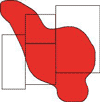Race and maps
I'm reading What it means to be 98% chimpanzee, by the anthropologist Jonathan Marks, who I met earlier this year at a symposium (he signed my book "100% human"!). Marks is an authority on race and genetics and his recent work has covered the intellectual history of race as a cultural construct.
In the book Marks compares the different approaches taken by Linnaeus and the comte de Buffon on the question of classification of species. Linnaeus favored a hierarchical structure of species--genera--orders--classes (or families). Now all life could be placed within this structure. Linnaeus had three special cases where he subdivided species into subspecies and humans were one of these (the others were dogs and sheep, showing perhaps what breeds were important in the 17th century!).
Buffon however spoke in a very different way. He rejected the classification of nature into units and instead emphasized its continually varying diversity. Where Linnaeus saw difference and discrete boun daries, Buffon saw continuity and variation.
Aha! This is like the two major approaches to mapping thematic data, one based on discrete boundaries and the other on continuity. In other words, like the choropleth map and the isopleth map. The two naturalists are emblematic of the way that we approach our problems today. While Linnaeus didn't use the term "race" for his subspecies, later scholars did, and it was around this time that the modern concept of race as a small group of well-defined peoples was invented. The parallel concept of the choropleth was not invented until the early 19th century (1826 to be precise). The conjunction of these concepts (race and discrete geographical units or race mapping) also came to prominance in the 19th century.
The trouble with both the Linnaean system and choropleth maps (despite the fact that they are both very popular) is that they take a continually varying phenomenon and apply a category over the top of it.
Take this cancer cluster for example (shown in red):
If we see this cancer through the grid of a choropleth map, say using counties (gray lines) we would likely conclude that 3 of the 4 counties have a high cancer risk and 1 of them has a negligible risk. We would be justified in making this conclusion and yet it is misleading. Even in those 3 high risk counties the risk is not everywhere and yet no doubt the public health message would be that people in those counties are at risk, when clearly many are not. Also even in the county with negligible risk (on the left) there are some people who are at risk and yet no doubt again the public health message would be based on the county as a whole (because that is what our data would show in the choropleth map).
This is analogous to the fallacy of race-based medicine, by the way (eg., sickle cell anemia) where the message goes out that blacks are at risk from it. Well no, it's got nothing to do with race, it depends on your hereditary exposure to malaria. Many light-skinned African peoples in North Africa, and others around the Mediterranean are also at higher risk from it. And of course not all blacks are at risk from it. Yet this becomes a "black" disease, unnecessarily worrying many people and not worrying others enough.
Marks also offers an interesting insight into why we are "mammals" which I hadn't heard before. On what basis did Linnaeus choose the mammae as his defining criterion? Mammals have lots of features that distinguish them from other species, including hair and the fact that we only have one bone in the lower jaw. Why didn't he choose those? It turns out that in the 17th century there was a controversy over breast-feeding. Many richer families were sending out their newborns to wetnurses. Linnaeus was an active opponenet of this and he called us mammals to underline the fact that we should be breast-feeding our own young. (Marks credits Schiebinger's book Nature's Body for this account.)
So the lesson is that while we use categories to order things these very categories are constructs to help us order the world and do not exist in nature itself. This can lead to insights--or equally to mistakes and obfuscations when we believe the categories are natural. This goes both for race and for the choropleth map.
No comments:
Post a Comment